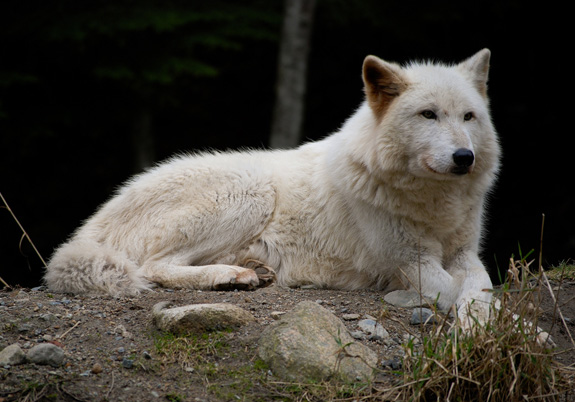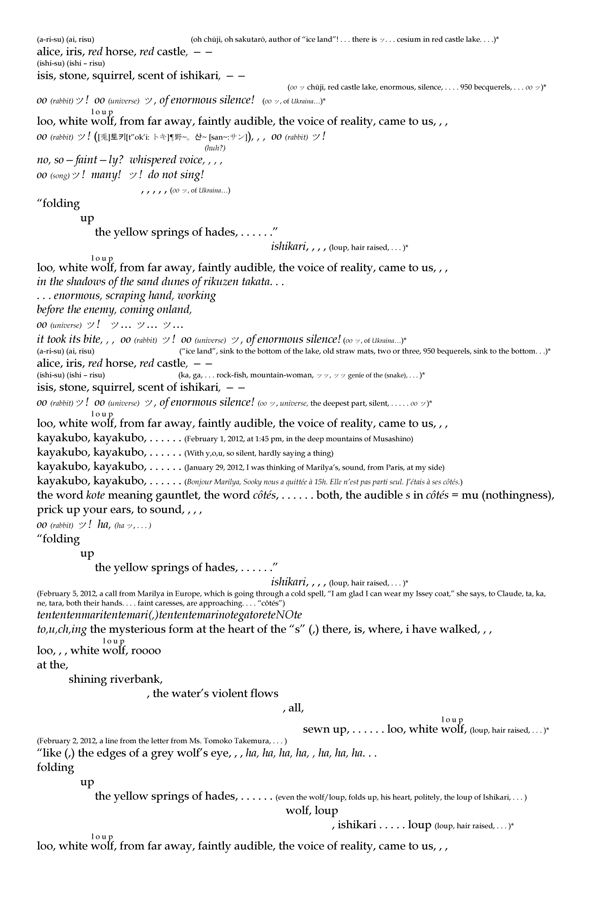At the request of the online version of the Asahi shinbun and Handbook of Contemporary Poetry, I have written this poem on the theme “To the post-3.11 world, as I see it,” but this is just the prelude. As day follows day, one step closes in upon another, one after the next,…at the root of language, one stitch, sewn together…that is how I have imagined my poetic production over the last year, ——. The title will probably be just what it has been all along… This work will probably amount to a long work of approximately three thousand lines,… Thank you to the people in charge and to my readers. — February 6, 2012, in Ishikari
Press the image to enlarge.
Author’s note: The text in small print was added on February 5, 2012 during a morning spent in the snow on the shores of Lake Red Castle (Akagi Ōnuma). [Translator’s note: This lake is located in Gunma Prefecture, not far from the birthplace of Sakutarō Hagiwara, the famous poet evoked in the small annotations early in the poem.]
Translator’s note: This poem appeared in the daily newspaper Asahi shinbun as part of a series of poems written by twelve of Japan’s most prominent poets in commemoration of the one-year anniversary of the March 11, 2011 earthquake, tsunami, and nuclear meltdown. Many of the proper names are place names from the devastated regions of northeastern Japan. In particular, the Ishikari River is a place that has impressed Yoshimasu deeply. Many years ago, he visited the snowy banks of Ishikari River and was so impressed by the desolate landscape there that he wrote the poem “Ishikari Sheets.” Yoshimasu returned there after the earthquake to read this poem.
In many places in this poem, Yoshimasu plays with the associations between words, their sound, and silence. For instance, in the comments that accompanied this poem in the online version of the Asahi shinbun, he commented that the symbol ッ represents the cessation of sound—a pause or silence within the sound of the poem itself. When following the sound oo, which sounds a bit like a short gasp, this silence might represent the moment in which a tear falls. Interestingly, Yoshimasu writes many of the sounds in hentaigana, using Chinese characters to represent pure sound. For instance, the sound oo, is sometimes written with the character meaning “rabbit” (兎) and sometimes with the character signifying “universe” (宇), thus introducing another dimension of meaning into the poem.
Translation necessarily breaks certain sound-related connections; however, in rendering this poem in English, I have found that other connections and patterns naturally form, growing in new, idiosyncratic directions in English, like crystals growing from smaller molecular structures. The Korean and French inclusions appear as they did in the original text, with no corrections to the grammar.
Gozo Yoshimasu (1939- ) is one of the most prominent figures in Japanese contemporary poetry. He became famous during the 1960s and 1970s for his avant-garde work, which employed chance operations, quotations, and other techniques to push Japanese poetry in radically new directions. His work frequently blurs the lines between creative writing, performance art, and visual art. His English translations include A Thousand Steps…And More (Katydid Books, 1987) and Osiris, The God of Stone (Katydid Books, 1989). The poem that appears here is from the forthcoming collection Aris, Iris, Red Horse, edited by Forrest Gander.
Jeffrey Angles (1971- ) is an associate professor of Japanese and translation at Western Michigan University. He is the author of Writing the Love of Boys (University of Minnesota, 2011) and translator of Killing Kanoko (Action Books, 2009), Forest of Eyes (University of California Press, 2010), and other works of prose and poetry. He has won numerous grants and awards, including the Landon Translation Prize from the American Academy of Poets. He also writes poetry, primarily in Japanese.

